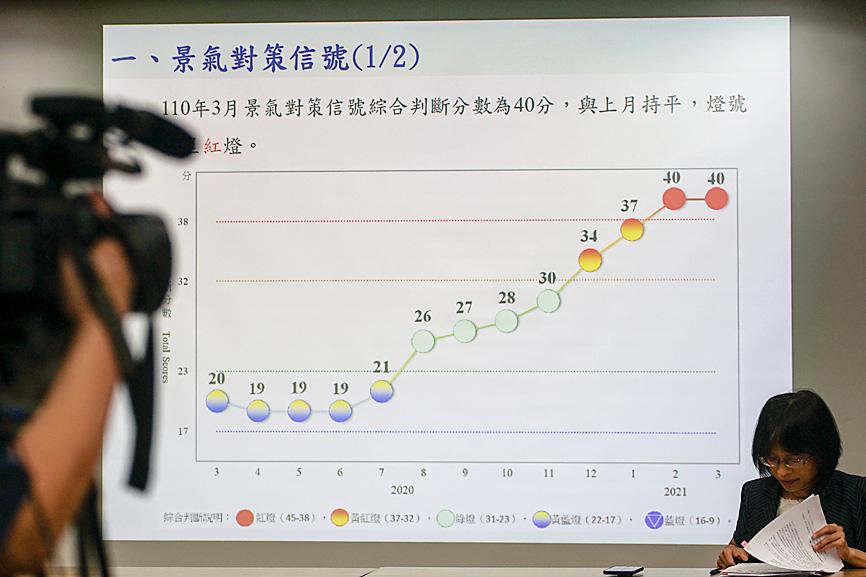The government’s business climate monitor last month was “red” for the second consecutive month, suggesting a boom amid signs that the world is emerging from the COVID-19 pandemic, despite an escalation of infections in India and other countries, the National Development Council said yesterday.
The overall reading was steady at 40, while the nine constituent gauges consolidated at high levels, the council said, adding that the monitor is expected to remain red this quarter, with major economic barometers tipped to be strong.
“Taiwan’s exports still have room to move upward as they move forward with the world on track for recovery from the pandemic,” NDC research director Wu Ming-huei (吳明蕙) told a media briefing.

Photo: CNA
The council uses a five-color system to depict the nation’s economic situation, with “green” indicating steady growth, “red” suggesting a boom and “blue” signaling a recession. Dual colors indicate a transition.
Wu dismissed overheating concerns, as red reflects healthy economic fundamentals, primarily impressive corporate earnings.
That explains why the local bourse has repeatedly reached records this month, Wu said.
All of the measures rose, except non-farm payrolls, Wu said.
The index of leading indicators, which aims to portray the economic situation for the subsequent six months, increased 0.12 percent to 105.35, as readings on imports of semiconductor capital equipment, manufacturing business confidence and labor entry rates rose, the council said.
The leading index has increased for 11 months in a row, with a cumulative gain of 9.15 percent, lending support to the council’s upbeat sentiment, Wu said.
The index of coincident indicators, which reflects the current economic state, increased 0.84 percent to 105.98, while the index has risen 9.18 percent in the past 10 months, the council said.
Industrial output, manufacturing sales, imports of machinery and electrical equipment, as well as wholesale and restaurant revenue, all gained ground, it said.
Exports and domestic demand have bolstered the economy, Wu said.

CHIP RACE: Three years of overbroad export controls drove foreign competitors to pursue their own AI chips, and ‘cost US taxpayers billions of dollars,’ Nvidia said China has figured out the US strategy for allowing it to buy Nvidia Corp’s H200s and is rejecting the artificial intelligence (AI) chip in favor of domestically developed semiconductors, White House AI adviser David Sacks said, citing news reports. US President Donald Trump on Monday said that he would allow shipments of Nvidia’s H200 chips to China, part of an administration effort backed by Sacks to challenge Chinese tech champions such as Huawei Technologies Co (華為) by bringing US competition to their home market. On Friday, Sacks signaled that he was uncertain about whether that approach would work. “They’re rejecting our chips,” Sacks

NATIONAL SECURITY: Intel’s testing of ACM tools despite US government control ‘highlights egregious gaps in US technology protection policies,’ a former official said Chipmaker Intel Corp has tested chipmaking tools this year from a toolmaker with deep roots in China and two overseas units that were targeted by US sanctions, according to two sources with direct knowledge of the matter. Intel, which fended off calls for its CEO’s resignation from US President Donald Trump in August over his alleged ties to China, got the tools from ACM Research Inc, a Fremont, California-based producer of chipmaking equipment. Two of ACM’s units, based in Shanghai and South Korea, were among a number of firms barred last year from receiving US technology over claims they have

It is challenging to build infrastructure in much of Europe. Constrained budgets and polarized politics tend to undermine long-term projects, forcing officials to react to emergencies rather than plan for the future. Not in Austria. Today, the country is to officially open its Koralmbahn tunnel, the 5.9 billion euro (US$6.9 billion) centerpiece of a groundbreaking new railway that will eventually run from Poland’s Baltic coast to the Adriatic Sea, transforming travel within Austria and positioning the Alpine nation at the forefront of logistics in Europe. “It is Austria’s biggest socio-economic experiment in over a century,” said Eric Kirschner, an economist at Graz-based Joanneum

BUBBLE? Only a handful of companies are seeing rapid revenue growth and higher valuations, and it is not enough to call the AI trend a transformation, an analyst said Artificial intelligence (AI) is entering a more challenging phase next year as companies move beyond experimentation and begin demanding clear financial returns from a technology that has delivered big gains to only a small group of early adopters, PricewaterhouseCoopers (PwC) Taiwan said yesterday. Most organizations have been able to justify AI investments through cost recovery or modest efficiency gains, but few have achieved meaningful revenue growth or long-term competitive advantage, the consultancy said in its 2026 AI Business Predictions report. This growing performance gap is forcing executives to reconsider how AI is deployed across their organizations, it said. “Many companies